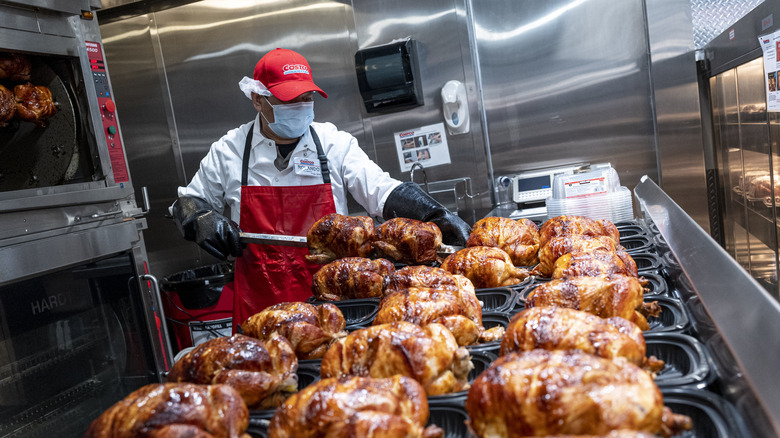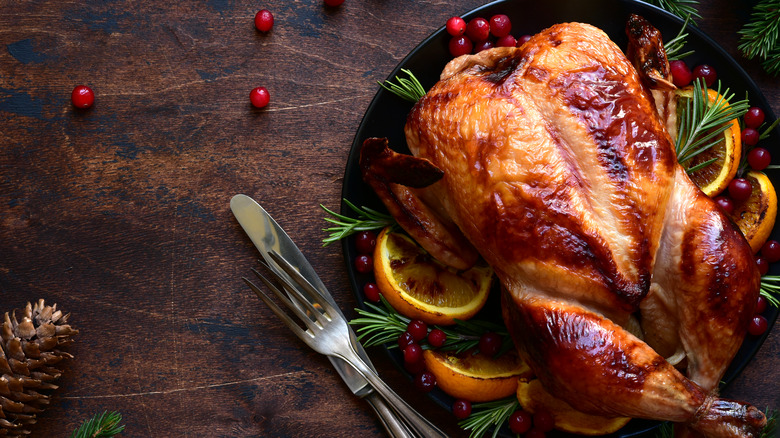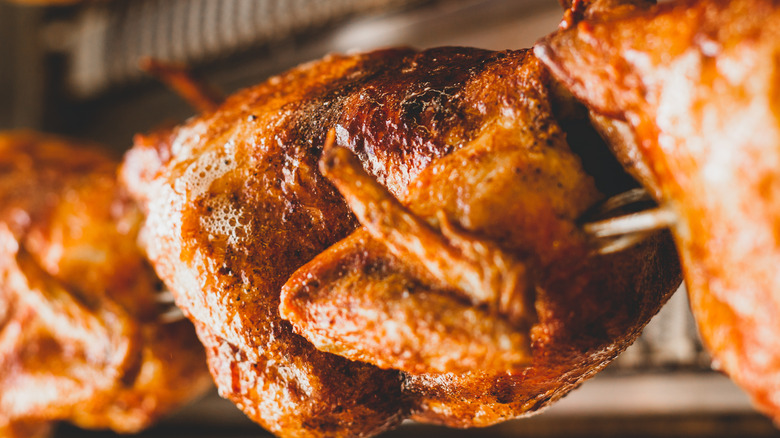Read This Before Buying Rotisserie Chicken From The Store
At some point, the dietary meme that protein should outweigh all other considerations took hold. So, a whole rotisserie chicken should offer a good blob of protein, no? Unfortunately, this is not the case. At least, it's not true if we're taking Costco's rotisserie chicken into consideration, which is lauded as the best grocery store rotisserie chicken by Taste of Home. Rotisserie chickens cooked at home may differ, but if you want the cheapest rotisserie chicken option, you go to Costco. It also helps that these chickens have a nutritional index against which we can peg our hopes for a healthy supper.
Looking at the nutritional values given by My Food Diary and FatSecret, you quickly see that while the chicken does indeed provide protein, it comes with other, unhealthier contents. For 3 ounces of chicken, you would consume 19 grams of protein. However, the same amount would also feed you 460 milligrams of sodium. You also must take into account the fact that, as Eat This, Not That! reports, Costco carefully ensures that their rotisserie chickens are 3 pounds.
Assuming that the nutritional values scale with the increased weight, the whole bird does indeed bring a good 304 grams of protein and 11.5 milligrams of iron to your diet, but this offsets any benefits by overloading you with 40 grams of saturated fat, 880 milligrams of cholesterol, and 7,360 milligrams of sodium. In the final case, that is more than three times the maximum the American Heart Association begrudgingly recommends.
What if you still want chicken?
Those nutritional red lights may worry you, but not dissuade your cravings for chicken. Unfortunately, as a separate Eat This, Not That! piece notes, you cannot have a low sodium rotisserie chicken: "If sodium is a concern, then opt for the non-flavored birds." You can avoid this by purchasing a chicken and roasting it in the oven yourself, as the sodium in a rotisserie chicken is not a natural byproduct of its biology, but the result of the rotisserie chicken's manufacturing process. As stated, the sodium levels we have examined are the ones found in Costco's chickens. Differently prepared rotisserie chickens may have higher or lower sodium levels.
However, if sodium is not the biggest concern, then one way you can alter the rotisserie chicken into a healthier version is by skinning the carcass. Women's Health explains that the chicken's skin contains a lot of its saturated fat. However, it is also that saturated fat that makes the skin so flavorful to begin with.
Essentially, a rotisserie chicken is a convenient way to have a chicken supper, but if you worry about your nutritional intake, you should probably not buy one. If you do buy one, though, and want to balance it with a more healthy array of sides, you can tear the meat into pieces for a Mediterranean bowl, as suggested in the Eat This, Not That! article, or follow the advice of Women's Health and incorporate it in a soup with kale.
You could just cook your own rotisserie chicken
Of course, if you still want a rotisserie chicken, the best choice would be to cook your own instead of purchasing it from the heated shelves of one of your favorite grocery stores. As Healthline explains, most of the problematic elements of the rotisserie chicken are due to the preservatives or seasonal blendings that people use to prepare them. In other words, rotisserie chickens are not unhealthy on a metaphysical level.
Moreover, while rotisserie chickens may sound like they need a lot of investment in equipment, a simple search on Amazon shows how easy is to procure a rotisserie kit for your grill.
The actual cooking of the chicken is relatively simple as well. Following The Spruce Eat's advice, you'll want to source a plain, whole chicken and then truss it and stick a lemon or some other flavoring spheroid onto the spit. This will hold the hollow chicken in place as the rotisserie rotates. Once you've done this, secure the chicken on the spit.
With the bird firmly stuck, you can start the grill, baste and flavor the bird as you will, and cook it as you would cook most things on the grill. The whole process will take about two hours, depending on the chicken's size. The time factor is why most people buy their chicken from stores, but spending your time here means you know exactly what goes into the bird and can control the flavors, spices, and other additives that season it.


